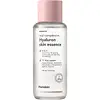What's inside
What's inside
 Key Ingredients
Key Ingredients

 Benefits
Benefits

 Ingredients Side-by-side
Ingredients Side-by-side

Water
Skin ConditioningGlycerin
HumectantButylene Glycol
HumectantPentylene Glycol
Skin ConditioningLinum Usitatissimum Seed Extract
PerfumingHydrolyzed Collagen
EmollientRhus Semialata Extract
Skin ConditioningGynostemma Pentaphyllum Leaf/Stem Extract
AntioxidantZostera Marina Extract
Skin ConditioningCeramide AP
Skin Conditioning1,2-Hexanediol
Skin ConditioningSodium Hyaluronate
HumectantHydroxyethylcellulose
Emulsion StabilisingCitric Acid
BufferingSodium Citrate
BufferingHydrolyzed Hyaluronic Acid
HumectantSaccharide Isomerate
HumectantHydrolyzed Algin
Disodium EDTA
Phenoxyethanol
PreservativeWater, Glycerin, Butylene Glycol, Pentylene Glycol, Linum Usitatissimum Seed Extract, Hydrolyzed Collagen, Rhus Semialata Extract, Gynostemma Pentaphyllum Leaf/Stem Extract, Zostera Marina Extract, Ceramide AP, 1,2-Hexanediol, Sodium Hyaluronate, Hydroxyethylcellulose, Citric Acid, Sodium Citrate, Hydrolyzed Hyaluronic Acid, Saccharide Isomerate, Hydrolyzed Algin, Disodium EDTA, Phenoxyethanol
 Reviews
Reviews

Ingredients Explained
These ingredients are found in both products.
Ingredients higher up in an ingredient list are typically present in a larger amount.
1,2-Hexanediol is a synthetic liquid and another multi-functional powerhouse.
It is a:
- Humectant, drawing moisture into the skin
- Emollient, helping to soften skin
- Solvent, dispersing and stabilizing formulas
- Preservative booster, enhancing the antimicrobial activity of other preservatives
Butylene Glycol (or BG) is used within cosmetic products for a few different reasons:
Overall, Butylene Glycol is a safe and well-rounded ingredient that works well with other ingredients.
Though this ingredient works well with most skin types, some people with sensitive skin may experience a reaction such as allergic rashes, closed comedones, or itchiness.
Learn more about Butylene GlycolPhenoxyethanol is a preservative that has germicide, antimicrobial, and aromatic properties. Studies show that phenoxyethanol can prevent microbial growth. By itself, it has a scent that is similar to that of a rose.
It's often used in formulations along with Caprylyl Glycol to preserve the shelf life of products.
Sodium Hyaluronate is hyaluronic acid's salt form. It is commonly derived from the sodium salt of hyaluronic acid.
Like hyaluronic acid, it is great at holding water and acts as a humectant. This makes it a great skin hydrating ingredient.
Sodium Hyaluronate is naturally occurring in our bodies and is mostly found in eye fluid and joints.
These are some other common types of Hyaluronic Acid:
Learn more about Sodium Hyaluronate